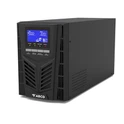Photovoltaic: It is the abbreviation of solar photovoltaic power generation system (Solar power system). It is a new power generation system that uses the photovoltaic effect of solar cell semiconductor materials to directly convert solar radiation energy into electrical energy. There are two modes of independent operation and grid-connected operation.
At the same time, the classification of solar photovoltaic power generation systems, one is centralized, such as large-scale ground photovoltaic power generation systems in Northwest China; the other is distributed (>6MW is the boundary), such as industrial and commercial enterprise factory roof photovoltaic power generation systems, residential roof photovoltaic power generation systems.

The current mainstream solar power generation method is to use crystalline silicon panels to generate electricity. Ideally, a monocrystalline silicon cell with an area of about 2.3 square meters can generate about 3-4 degrees of electricity per day. Generally, household air conditioners need about 4 boards, electric water heaters, electric kettles and other household appliances need 2 boards, refrigerators, washing machines, TVs, and computers need 1 board in total, and household lighting needs 0.5 boards. In addition, if solar energy is used to power electric vehicles, 4 battery panels are required for an average driving distance of 50 kilometers. If the home is a large villa or a rural area with a relatively large area, a distributed photovoltaic system can be installed separately, and panels can be placed on the wide courtyard and roof to meet the needs of a family of four. A happy life needs about 19 panels of 2.6㎡.

With all that said, how many solar panels do you think will cover your home electricity plan? Wondering if you've ever noticed how your water heater works? If powered by solar cells, how should the batteries be installed? In addition, what other electrical appliances in your home use solar cells to generate electricity? You can simply calculate the daily power consumption and total power consumption of each appliance in your home, and you can roughly get the proportion of your monthly electricity bill.

With the vigorous development of the distributed photovoltaic market, Suoyan adheres to the orientation of user needs and technological innovation, takes the research and development of beautiful, efficient, intelligent and reliable products as its own responsibility, and focuses on being a professional manufacturer of high-quality photovoltaic products. - Terminal energy storage photovoltaic power supply. Structural design and raw material selection are extremely strict, and strive to provide highly reliable and efficient products, and are committed to injecting new vitality into the new energy industry.






